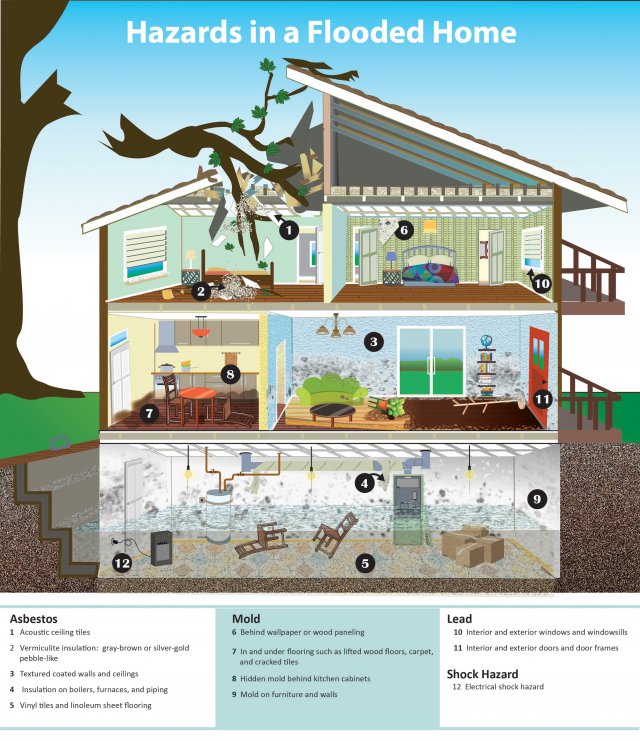Protecting Your Health
You can download the PDF for printing, or click on the image for a larger view.
Hazards in a Flooded Home (pdf)
Asbestos Hazards
Older homes, including apartments, may contain asbestos. Learn about what materials may contain asbestos, and how to protect you and your family from serious health risks, like lung cancer, from airborne asbestos fibers.
Visit EPA Asbestos for more information on asbestos safety.
Contact the EPA TSCA Assistance Information Service at (202) 554-1404 or send an email to TSCA Hotline (tsca-hotline@epa.gov) for information on steps you should take to avoid exposure.
Lead Paint Hazards
Lead is a highly toxic metal that produces a range of adverse health effects, particularly in young children. Disturbance or removal of materials containing lead-based paint may result in an elevated concentration of lead dust in the air. This video will show you how to protect yourself and your family from lead-based paint while renovating your home.
Visit EPA Lead for more information on lead safety.
Contact the National Lead Information Center:
- if you know or suspect that your home contains lead-based paint,
- to receive a general information packet or to order other documents
- or for detailed information or questions.
Call and speak with a specialist Monday through Friday, 8:00 a.m. to 6:00 p.m. Eastern time (except federal holidays) at 1-800-424-LEAD (5323).
Mold and Bacteria
Flood water can make the air in your home unhealthy. This is because when things remain wet for more than two days, they usually get moldy.
Inhaling mold can cause adverse health effects, including allergic reactions. Mold also can damage materials in your home. In addition, flood water may contain microorganisms, such as bacteria, or chemical hazards. Exposure to contaminated flood water can cause health concerns like wound infections, rash, and more.
- Identify what items you can keep or should throw away.
- Learn more about mold and mildew on textiles on the Smithsonian Museum Conservation website.
- Learn how to identify mold and how to clean moldy objects (provided by the CDC), Flood Waters or Standing Waters.
Mosquitoes
Eliminate standing water where mosquitoes can breed.
Mosquitoes can sharply increase after a flood, due to the sudden availability of standing water which they require for breeding -- even very small amounts of water. As flood waters recede, be sure to drain, overturn, or empty areas -- no matter how small -- to reduce mosquito breeding areas and help reduce the spread of mosquito-borne diseases.
- Get rid of standing water in rain gutters, old tires, buckets, plastic covers, toys, pools, or any other containers.
- Empty water from damaged materials that aren't usually outdoors, such as discarded furniture, household items, bookshelves, building materials, trash, etc.
- Drain wet areas and puddles of water, or fill them with dirt.
- More ideas for controlling mosquitoes.
Generator Hazards
Generators, gas or camp stoves, and fuel-burning lanterns all produce carbon monoxide, or CO, which can kill you in minutes if you breathe it in. Use the tips in this video to avoid carbon monoxide poisoning and keep your family safe.

